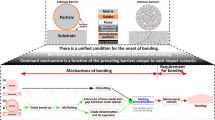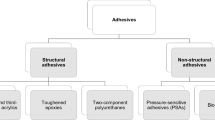Abstract
Partial transient liquid-phase (PTLP) bonding is currently an esoteric joining process with limited applications. However, it has preferable advantages compared with typical joining techniques and is the best joining technique for certain applications. Specifically, it can bond hard-to-join materials as well as dissimilar material types, and bonding is performed at comparatively low temperatures. Part of the difficulty in applying PTLP bonding is finding suitable interlayer combinations (ICs). A novel interlayer selection procedure has been developed to facilitate the identification of ICs that will create successful PTLP bonds and is explained in a companion article. An integral part of the selection procedure is a filtering routine that identifies all possible ICs for a given application. This routine utilizes a set of customizable parameters that are based on key characteristics of PTLP bonding. These parameters include important design considerations such as bonding temperature, target remelting temperature, bond solid type, and interlayer thicknesses. The output from this routine provides a detailed view of each candidate IC along with a broad view of the entire candidate set, greatly facilitating the selection of ideal ICs. This routine provides a new perspective on the PTLP bonding process. In addition, the use of this routine, by way of the accompanying selection procedure, will expand PTLP bonding as a viable joining process.












Similar content being viewed by others
Notes
See the companion article for details.
The term homogenize is used to refer to the steady-state condition of the bond since that composition can reside in a two-phase region (see Section II–C–2 for more information).
Values for T B ranged from 293 K to 3773 K (20 °C to 3500 °C). Thickness values were randomly selected from comprehensive ranges reported in a review article of PTLP bonding:[1] 20 to 1000 µm for thRC and 1 to 50 pct of thRC for thD. Each run (100 total) generated between 2340 and 52,900 possible ICs (see Section IV for details of IC formation).
These temperatures can be equal.
Because PTLP bonds are not composed of a single element, they possess solidus and liquidus temperatures (as do alloys) if their composition is not eutectic or azeotropic. Throughout this article, the melting (or remelting) temperature of the PTLP bond refers to its solidus temperature.
If present, all allotropic regions, and the two-phase regions between them, are then grouped together to form a larger solid solution region. A PTLP bond composed of a two-phase allotropic region will likely exhibit ductility similar to solid type 2 (explained in Section II–C–2). Such regions are noticeable in plots resulting from this routine (e.g., see the solid type 1 region in Figure 10) and can be treated similar to solid type 2, if desired.
This routine does not differentiate between intermediate solid solution regions that are very thin (spanning about 0.25 at. pct) and very wide (spanning about 40 at. pct).
Outermost is with respect to the RC element.
The binary systems in the comprehensive binary system database contain the following solid profile sets: 1; 1,2; 1,3; 1,2,3; 1,2,4; 1,3,5; 1,2,3,5; 1,2,4,5; 1,2,3,4,5; 4; 4,5; and 5. A few other combinations, such as 1,3,4, are theoretically possible, but they do not exist in actual phase diagrams. The companion article lists which binary systems are included in this database.
When determining data points for each profile, a few discrepancies were found between the location of the point, as determined by the axes, and concentrations and/or temperatures specified in the diagram. In these cases, it was necessary to use the data point determined by the axes to accurately represent the overall shape of the phase diagram.
Binary systems for which the liquidus concentration at the maximum solid temperature is less than 3 at. pct (e.g., Al-Sb, Ce-W, or Ge-Mg) were removed from the binary system framework (see Criterion B in the companion article).
Some binary systems cause more than two liquid regions to form at specific temperatures. For example, three liquid regions (and five solid–liquid boundaries) would form in Ag-Sr at 923 K (650 °C) while four (and seven) would form in Al-Zr at 1793 K (1520 °C). All multiple liquid regions in each binary system and IC are grouped together to display comprehensive multiple liquid region temperature ranges.
When elements are sorted by E, G tends to follow the same trend with some minor deviations. Values for the ratio E/G tend to range from 2.3 to 2.9, while outlier elements include Mo (16.45), U (1.87), and Li (1.17). Sorting by G (as opposed to E) will therefore provide a slightly different ordering. Furthermore, some elements have reported values for G but not for E (e.g., Os and Sr).
Four of the six intermetallics occur at locations not coinciding with solid profiles; two of them are beyond the scale of the plot, and therefore appear outside. This occurs for two possible reasons: the intermetallics belong to the less-limiting binary system (for nonsymmetric ICs), or they occur on the side of a eutectic trough opposite the RC element.
This analysis assumes that the diffusion coefficient of E1 in E3 is higher than that of E1 in E3–E2. It also ignores anomalies such as the uphill diffusion seen in rare cases, such as in Fe-Si-C.
This temperature is drawn from either the phase diagram or element boiling points and is reported for those systems where it is below the melting point of the refractory element.
References
G.O. Cook III and C.D. Sorensen: J. Mater. Sci., 2011, vol. 46, pp. 5305–5323. doi:10.1007/s10853-011-5561-1.
G.O. Cook III and C.D. Sorensen: Metall. Mater. Trans. A, 2013. DOI:10.1007/s11661-013-1956-8.
W. Tillmann and E. Lugscheider: Int. J Join. Mat., 1996, vol. 8, pp. 56–61.
D.R. Askeland and P.P. Phulé: The science and engineering of materials, fifth ed, Thomson, Ontario, 2006.
A.M. Russell and K.L. Lee: Structure-property relations in nonferrous metals, Wiley, Hoboken, 2005.
S. Russ, C. Woodward, Y.W. Kim, and F. Yolton: Conf. Paper Prepr. AFRL-RX-WP-TP-2009-4154, 2008.
S. Ji, D. Watson, Z. Fan, and M. White: Mat. Sci. Eng. A, 2012, vol. 556, pp. 824–833.
J.A. Pask and I.A. Aksay: Mat. Sci. Res., 1974, vol. 9, pp. 433–444.
R.K. Wilcoxon, A.P. Boone, and J.R. Wooldridge: US Patent 7,830,021, 2010.
T. Gray: The Photographic Periodic Table of the Elements. http://www.periodictable.com/, 2010. Accessed 12 May 2011.
H. Okamoto: Desk Handbook: Phase Diagrams for Binary Alloys, ASM International, Materials Park, Ohio, 2000.
A. Schnell, A. Stankowski, and E. deMarcos: Proc. GT2006, ASME Turbo Expo 2006: Power For Land, Sea, Air, Barcelona, 2006.
W.D. Kay: ASM Handbook: welding, brazing, soldering, vol. 6, ASM International, Metals Park, 1993.
N.S. Bosco and F.W. Zok: Acta. Mater., 2004, vol. 52, pp. 2965–2972.
Y. Zhou, W.F. Gale, and T.H. North: Int. Mater. Rev., 1995, vol. 40, pp. 181–196.
Z. Li, Y. Zhou, and T.H. North: J. Mater. Sci., 1995, vol. 30, pp. 1075–1082. doi:10.1007/BF01178448.
G.O. Cook III: Ph.D. Dissertation, Brigham Young University, 2011.
I. Tuah-Poku, M. Dollar, and T.B. Massalski: Metall. Trans. A, 1988, vol. 19A, pp. 675–686.
M.L. Shalz, B.J. Dalgleish, A.P. Tomsia, and A.M. Glaeser: J. Mater. Sci., 1993, vol. 28, pp. 1673–1684. doi:10.1007/BF00363367.
Acknowledgments
The current study was funded by the Office of Naval Research under Grant Number N00014-07-1-0872, thanks to Dr. William Mullins, Program Officer.
Author information
Authors and Affiliations
Corresponding author
Additional information
Manuscript submitted December 27, 2012.
Appendices
Appendix A
For half of the IC, the RC and diffusant element volumes are given by
Because the cross-sectional area (A) is constant across the IC, volumes can be simplified to the interlayer thicknesses. These values are then multiplied by room-temperature densities and divided by atomic weights (values taken from Reference 10) to produce molar amounts:
The number of diffusant element moles (Eq. [A4]) is the same for the binary and ternary cases.
The at. pct of the RC element and a diffusant element are then given by
To calculate the ternary composition, the complete volume of the RC,
is used to calculate the number of moles present in the complete RC layer:
The at. pct of the RC element and one of the diffusant elements are given by Eqs. [A9] and [A10]:
If the ternary composition resides on the line connecting the two binary compositions, then it will satisfy the basic equation for a line, shown in Eq. [A11] with the appropriate values inserted:
Substituting Eqs. [A6] and [A10] into the right-hand side of Eq. [A11] yields
Since n RC,bin = n RC,ter/2, simplifying Eq. [A12] yields
Creating a common denominator produces
And simplifying the numerator yields
which simplifies to Eq. [A10] and proves that the ternary composition resides on the line connecting the binary compositions.
Appendix B
For a binary system, the conversion from atomic (c) to weight (w) percent is accomplished by calculating the weighting factors shown in Eqs. [B1] and [B2] and substituting them into the ratio shown in Eq. [B3]. The result of this substitution is shown in Eq. [1] (Section II–D).
In similar fashion, the conversion from weight to volume (v) percent is accomplished by calculating the weighting factors shown in Eqs. [B4] and [B5] and substituting them into Eq. [B6], resulting in Eq. [2] (Section II–D).
Rights and permissions
About this article
Cite this article
Cook, G.O., Sorensen, C.D. Partial Transient Liquid-Phase Bonding, Part II: A Filtering Routine for Determining All Possible Interlayer Combinations. Metall Mater Trans A 44, 5754–5772 (2013). https://doi.org/10.1007/s11661-013-1957-7
Published:
Issue Date:
DOI: https://doi.org/10.1007/s11661-013-1957-7




